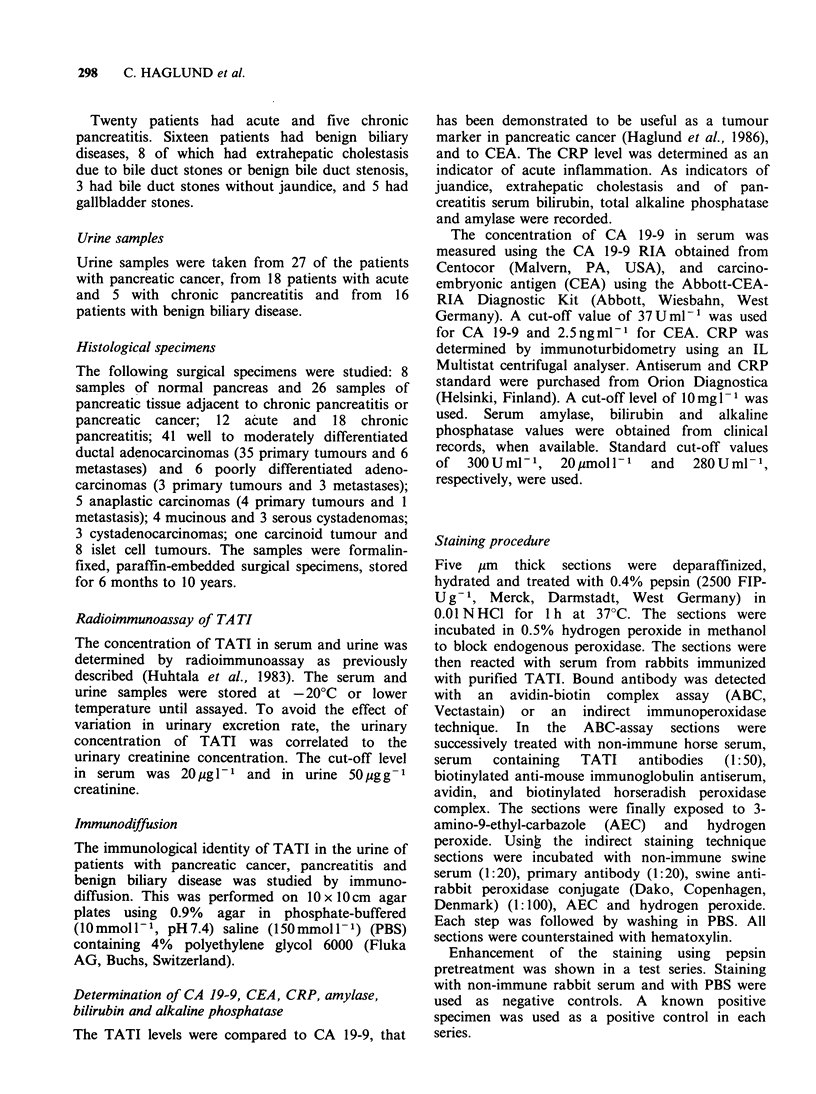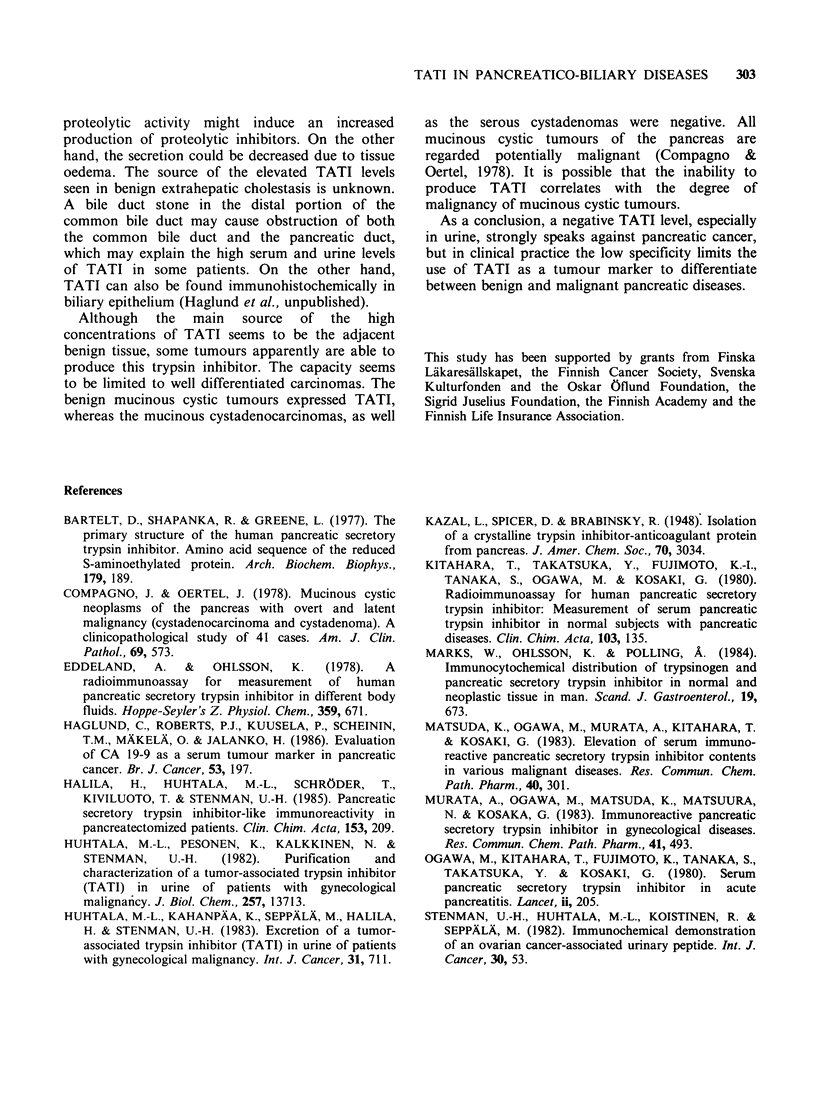Abstract
The serum and urine concentrations of a tumour-associated trypsin inhibitor, TATI, were determined by radioimmunoassay in patients with pancreatic cancer and with benign pancreatic and biliary diseases. Elevated serum levels (greater than 20 micrograms l-1) were found in 85% of the patients with pancreatic cancer, and elevated urine levels (greater than 50 micrograms g-1 creatinine) in 96% of the patients. Thus low TATI level, especially in urine, makes the possibility of pancreatic cancer less likely. Serial assay of TATI in serum from three patients with surgically removed pancreatic cancer showed elevation of the TATI level at the time of detection of recurrence. However, high serum and urine levels were also seen in pancreatitis and in benign extrahepatic cholestasis. Thus TATI is a sensitive, although not specific, indicator of pancreatic and biliary disease, but the use of TATI as a tumour marker in the primary diagnosis of pancreatic cancer is limited. Immunohistochemical staining of pancreatic lesions showed that half of the pancreatic tumours expressed TATI, but the pancreatic tissue adjacent to a carcinoma always stained stronger than the carcinoma. It therefore seems that the main source of TATI in serum and urine of patients with pancreatic cancer are the normal acini and not the tumour tissue. In pancreatitis the staining was intense and clearly stronger than in normal pancreas.
Full text
PDF






Images in this article
Selected References
These references are in PubMed. This may not be the complete list of references from this article.
- Bartelt D. C., Shapanka R., Greene L. J. The primary structure of the human pancreatic secretory trypsin inhibitor. Amino acid sequence of the reduced S-aminoethylated protein. Arch Biochem Biophys. 1977 Feb;179(1):189–199. doi: 10.1016/0003-9861(77)90103-5. [DOI] [PubMed] [Google Scholar]
- Compagno J., Oertel J. E. Mucinous cystic neoplasms of the pancreas with overt and latent malignancy (cystadenocarcinoma and cystadenoma). A clinicopathologic study of 41 cases. Am J Clin Pathol. 1978 Jun;69(6):573–580. doi: 10.1093/ajcp/69.6.573. [DOI] [PubMed] [Google Scholar]
- Eddeland A., Ohlsson K. A radioimmunoassay for measurement of human pancreatic secretory trypsin inhibitor in different body fluids. Hoppe Seylers Z Physiol Chem. 1978 Jun;359(6):671–675. doi: 10.1515/bchm.1978.359.1.671. [DOI] [PubMed] [Google Scholar]
- Haglund C., Roberts P. J., Kuusela P., Scheinin T. M., Mäkelä O., Jalanko H. Evaluation of CA 19-9 as a serum tumour marker in pancreatic cancer. Br J Cancer. 1986 Feb;53(2):197–202. doi: 10.1038/bjc.1986.35. [DOI] [PMC free article] [PubMed] [Google Scholar]
- Halila H., Huhtala M. L., Schröder T., Kiviluoto T., Stenman U. H. Pancreatic secretory trypsin inhibitor-like immunoreactivity in pancreatectomized patients. Clin Chim Acta. 1985 Dec 31;153(3):209–216. doi: 10.1016/0009-8981(85)90354-7. [DOI] [PubMed] [Google Scholar]
- Huhtala M. L., Kahanpä K., Seppälä M., Halila H., Stenman U. H. Excretion of a tumor-associated trypsin inhibitor (TATI) in urine of patients with gynecological malignancy. Int J Cancer. 1983 Jun 15;31(6):711–714. doi: 10.1002/ijc.2910310606. [DOI] [PubMed] [Google Scholar]
- Huhtala M. L., Pesonen K., Kalkkinen N., Stenman U. H. Purification and characterization of a tumor-associated trypsin inhibitor from the urine of a patient with ovarian cancer. J Biol Chem. 1982 Nov 25;257(22):13713–13716. [PubMed] [Google Scholar]
- Kitahara T., Takatsuka Y., Fujimoto K. I., Tanaka S., Ogawa M., Kosaki G. Radioimmunoassay for human pancreatic secretory trypsin inhibitor: measurement of serum pancreatic secretory trypsin inhibitor in normal subjects and subjects with pancreatic diseases. Clin Chim Acta. 1980 Apr 25;103(2):135–143. doi: 10.1016/0009-8981(80)90205-3. [DOI] [PubMed] [Google Scholar]
- Marks W. H., Ohlsson K., Polling A. Immunocytochemical distribution of trypsinogen and pancreatic secretory trypsin inhibitor in normal and neoplastic tissues in man. Scand J Gastroenterol. 1984 Jul;19(5):673–676. [PubMed] [Google Scholar]
- Matsuda K., Ogawa M., Murata A., Kitahara T., Kosaki G. Elevation of serum immunoreactive pancreatic secretory trypsin inhibitor contents in various malignant diseases. Res Commun Chem Pathol Pharmacol. 1983 May;40(2):301–305. [PubMed] [Google Scholar]
- Murata A., Ogawa M., Matsuda K., Matsuura N., Kosaki G., Inoue M., Ueda G., Kurachi K. Immunoreactive pancreatic secretory trypsin inhibitor in gynecological diseases. Res Commun Chem Pathol Pharmacol. 1983 Sep;41(3):493–499. [PubMed] [Google Scholar]
- Ogawa M., Kitahara T., Fujimoto K., Tanaka S., Takatsuka Y., Kosaki G. Serum pancreatic secretory trypsin inhibitor in acute pancreatitis. Lancet. 1980 Jul 26;2(8187):205–205. doi: 10.1016/s0140-6736(80)90094-x. [DOI] [PubMed] [Google Scholar]
- Stenman U. H., Huhtala M. L., Koistinen R., Seppälä M. Immunochemical demonstration of an ovarian cancer-associated urinary peptide. Int J Cancer. 1982 Jul 15;30(1):53–57. doi: 10.1002/ijc.2910300110. [DOI] [PubMed] [Google Scholar]






